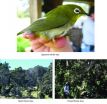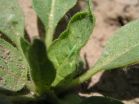(Press-News.org) Biologists Leonard Freed and Rebecca Cann from the University of Hawaii at Manoa have been studying birds at Hakalau Forest National Wildlife Refuge for 20 years. Located on an old cattle ranch on the windward slope of Mauna Kea on the Island of Hawaii, it was established in 1985 to protect 8 species of rare and endangered perching birds. The refuge and its volunteers planted over 400,000 seedlings of native koa trees in an abandoned pasture to restore high elevation forest. The once-rare white-eye colonized the restoration area, grew rapidly in it, but then surged into the old-growth forest below. Freed and Cann estimated that tens of thousands of native birds were lost. Their study was recently published in the open access journal NeoBiota.
The researchers had previously shown competition between white-eyes and native birds on their study sites. With increased numbers of white-eyes, young of all native species measured had stunted growth, indicating that food was becoming a problem. They also documented that birds of all ages had difficulty replacing their feathers. Each problem, both unprecedented in nature, occurred at the same time. In contrast to the forest adjacent to the restoration area, native birds deeper within the forest had normal growth and feather replacement where white-eyes were still rare.
Freed and Cann then used the refuge's own survey data collected over 3,373 ha of open forest and 1,998 ha of closed forest to determine if changes observed on their study sites were a general problem on the entire refuge. They documented a stepwise increase in density of white-eyes in the open forest area that had been sustained for 8 years between 2000 and 2007, and a more gradual increase in the closed forest area below that.
Loss of native birds followed the refuge-wide surge of white-eyes. Greater declines occurred in the open forest area where white-eyes increased first, amounting to a drop of one-third of native birds. About 10% of birds disappeared from the closed forest area, but there was strong correlation among losses of native species in the two areas. The researchers expect that losses in the more pristine closed forest area will continue, because the white-eye is still increasing there. Ironically, only an alien species is increasing on a refuge set aside to protect native Hawaiian birds. Forest restoration has precipitated a problem that requires additional action in the forest below. Hawaiian birds are considered to be "conservation reliant" species from other threats. Now the future of native birds on the refuge requires control of an introduced bird.
INFORMATION:
Original source:
Freed LA, Cann RL (2012) Increase of an introduced bird competitor in old-growth forest associated with restoration. NeoBiota 13: 43-60. doi: 10.3897/neobiota.13.2946
Posted by Pensoft Publishers.
An introduced bird competitor tips the balance against Hawaiian species
2012-05-23
ELSE PRESS RELEASES FROM THIS DATE:
Accident Prompts Minnesota to Issue Motorcycle Safety Warning
2012-05-23
Spring's early arrival in the Twin Cities caused many motorcycle enthusiasts to tune up their bikes and hit the road early this year. Unfortunately, this enthusiasm resulted in the death of a Lake Elmo motorcyclist. This accident prompted the Minnesota Department of Public Safety (DPS) to issue a motorcycle accident safety warning on March 16th.
DPS Motorcycle Safety Warning
The DPS warning is aimed at both motorists and bikers. It encourages drivers to be alert to the presence of motorcyclists around them and to double-check blind spots when changing lanes or making ...
Federal Compliance, Safety, Accountability Program for Truckers
2012-05-23
Federal truck-safety regulators released a new, improved program in December 2010 that changes the way the Federal Motor Carrier Safety Administration, the part of the U.S. Department of Transportation responsible for heavy-truck and large bus safety, enforces compliance with federal road-safety rules and regulations. The agency's priority is to reduce the rate of commercial-truck crashes and related injuries and deaths.
The FMCSA noticed the decreasing rate of truck accidents was dropping at a slower pace and undertook a comprehensive overview of how it could better ...
Robotic-assisted prostate cancer surgery drives up costs, UPMC study finds
2012-05-23
PITTSBURGH, May 23 – In one of the most comprehensive analyses to date of the cost of robotic-assisted, laparoscopic surgery for prostate cancer, researchers at UPMC found that this now-dominant surgical approach is significantly more costly than standard open surgery, despite little scientific evidence of long-term improved patient outcomes. The results of the study are available online and will appear in the July issue of the journal Urology.
In one of the first studies based on actual direct and indirect costs at a single institution—rather than computer models that ...
Millions of Seniors Still Drive, Study Finds
2012-05-23
As we get older, it becomes more difficult to do many everyday activities -- and driving is no different. Despite the challenges associated with driving as a senior citizen, the Insurance Institute for Highway Safety reports that 78 percent of people age 70 and above -- about 22 million seniors -- are still driving.
We're all familiar with media stories that involve senior citizens driving off the road, and sometimes injuring the unsuspecting people around them. But, statistics show that generally speaking, older drivers are not as much of a harm to others as you might ...
Deterring signals: Tobacco plants advertise their defensive readiness to attacking leafhoppers
2012-05-23
This press release is available in German.
Tobacco: actually pretty bad food for leafhoppers
Empoasca sp. is not a typical pest of wild tobacco (Nicotiana attenuata). When this plant grows in its natural habitats in North America, however, it is attacked by tobacco hornworm larvae (Manduca sexta). This specialist insect is resistant to the toxic nicotine, which the plant produces as a defense against its enemies. When researchers from the Max Planck Institute for Chemical Ecology used particular transgenic plants in field experiments, they noticed that these plants were ...
Drug Ads Often Gloss Over Side Effects, Enlist Doctor Endorsements
2012-05-23
Prescription drug advertisements have become ubiquitous in United States' media, including television and magazines. Unfortunately, these ads may be ultimately misleading about potential side effects, placing patients at risk.
How Drug Marketing Campaigns Portray Side Effects
Drug companies use several techniques to downplay the side effects of the potentially dangerous drugs they are advertising.
First, a drug company may enlist a celebrity to endorse its product. For example, the anti-inflammatory drug Enbrel is promoted by professional golfer Phil Mikelson. ...
How Traumatic Brain Injuries Affect Children
2012-05-23
Traumatic brain injury -- often called TBI -- is brain damage that can be caused by a blow or jolt to the head, as well as by an object penetrating the skull. Oftentimes, TBIs are not life threatening and those who suffer from mild injuries experience temporary brain-cell dysfunction -- which results in symptoms such as headaches, sleep-pattern changes, mood alterations and loss of consciousness that lasts for a few seconds to a few minutes.
In other cases, TBIs can be quite severe, causing serious damage or even death to the victims.
The Causes and Effects of Severe ...
Study supports urate protection against Parkinson's disease, hints at novel mechanism
2012-05-23
Use of the antioxidant urate to protect against the neurodegeneration caused by Parkinson's disease appears to rely on more than urate's ability to protect against oxidative damage. In the May issue of the open-access journal PLoS One, researchers from the MassGeneral Institute for Neurodegenerative Diseases (MGH-MIND) describe experiments suggesting the involvement of a novel mechanism in urate's protection of cultured brain cells against Parkinson's-like damage.
"Our experiments showed, unexpectedly, that urate's ability to protect neurons requires the presence of ...
'Obesity genes' may influence food choices, eating patterns
2012-05-23
PROVIDENCE, R.I. – Blame it on your genes? Researchers from The Miriam Hospital's Weight Control and Diabetes Research Center say individuals with variations in certain "obesity genes" tend to eat more meals and snacks, consume more calories per day and often choose the same types of high fat, sugary foods.
Their study, published online by the American Journal of Clinical Nutrition and appearing in the June issue, reveals certain variations within the FTO and BDNF genes – which have been previously linked to obesity – may play a role in eating habits that can cause obesity. ...
How to Improve Your Credit After Bankruptcy
2012-05-23
If you have filed for bankruptcy, you may wonder what your credit will look like after you obtain your discharge of debt. You understand that a bad credit rating means credit cards and loans will be more expensive and harder to get. However, you may be surprised to find your credit could be better than you expect.
Bad Credit?
The good news is your credit can probably only improve. If you had to file bankruptcy, your financial situation was probably rather unstable. All of your creditors were aware of this; after all, they were the ones harassing you to pay their bills.
Once ...

